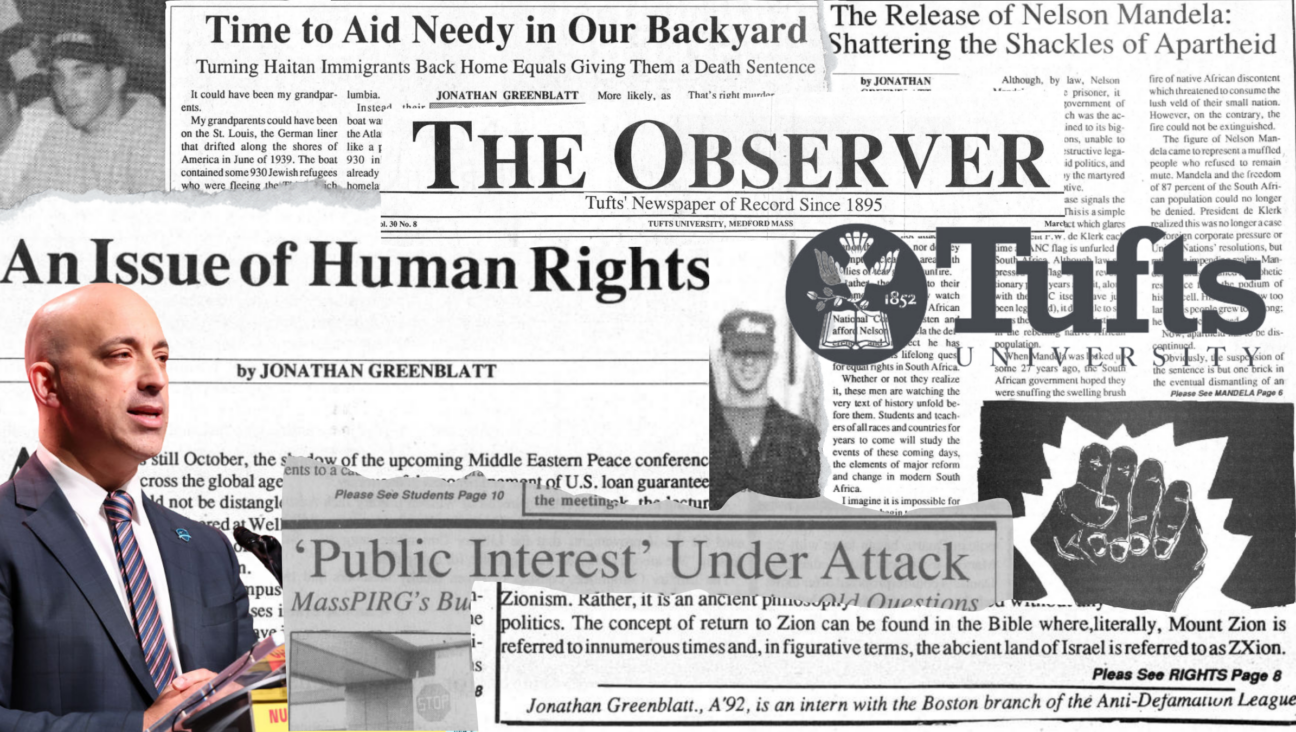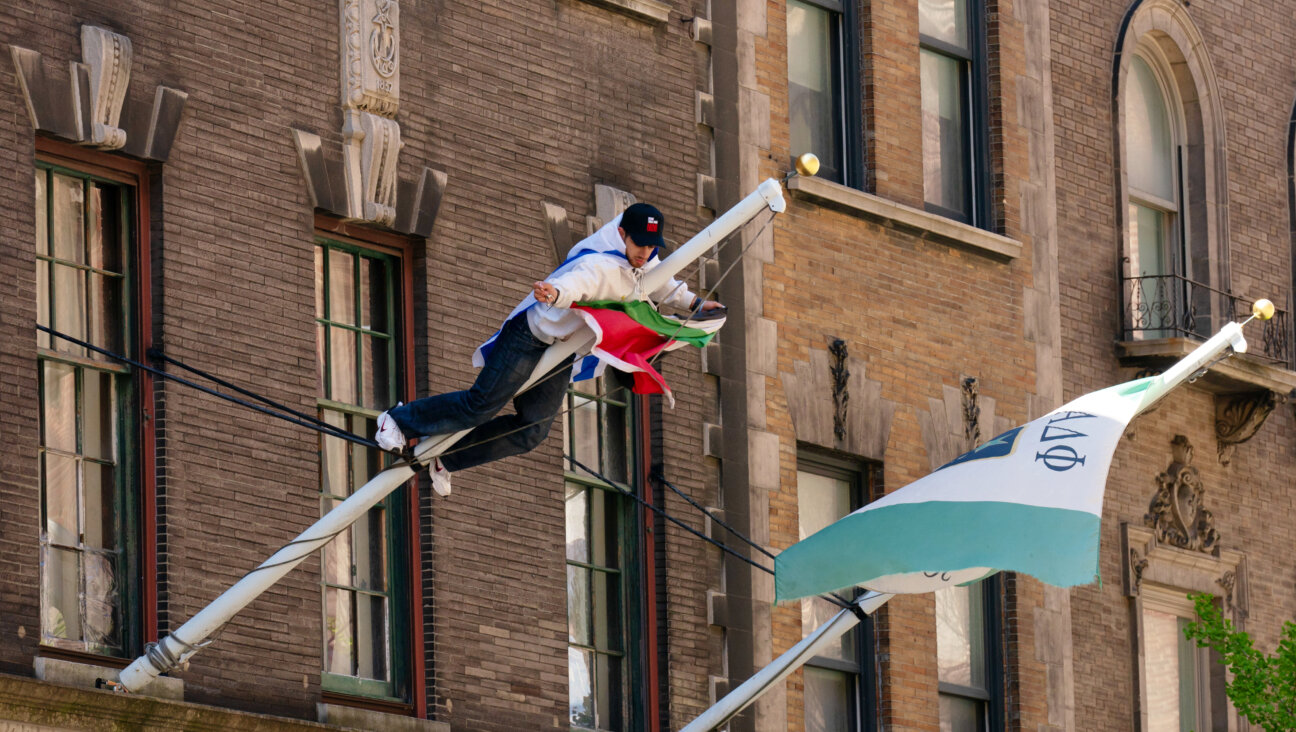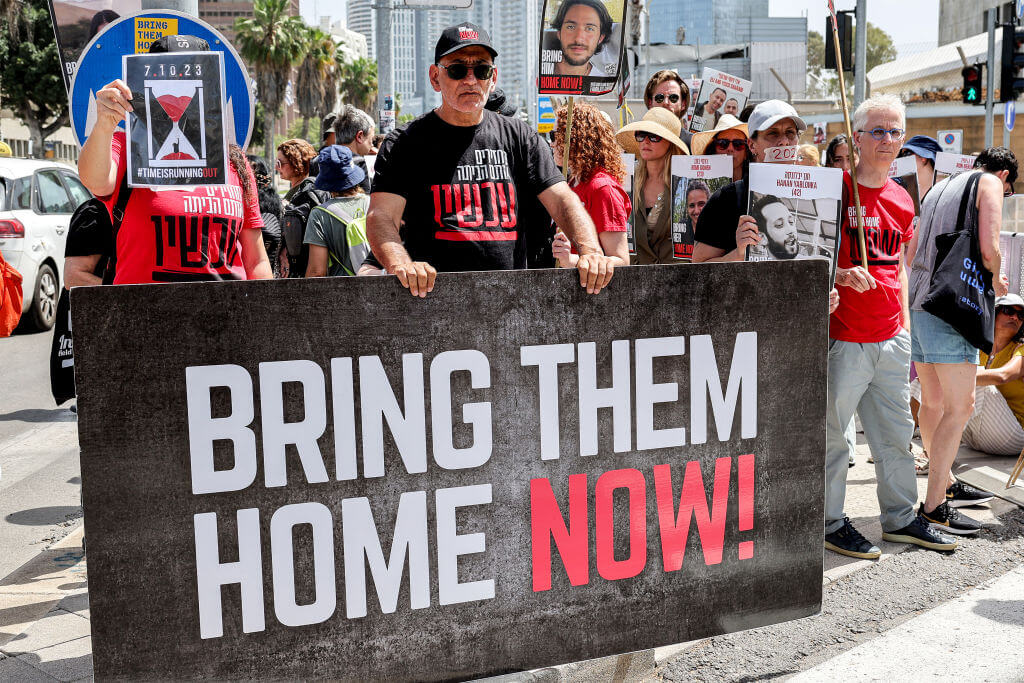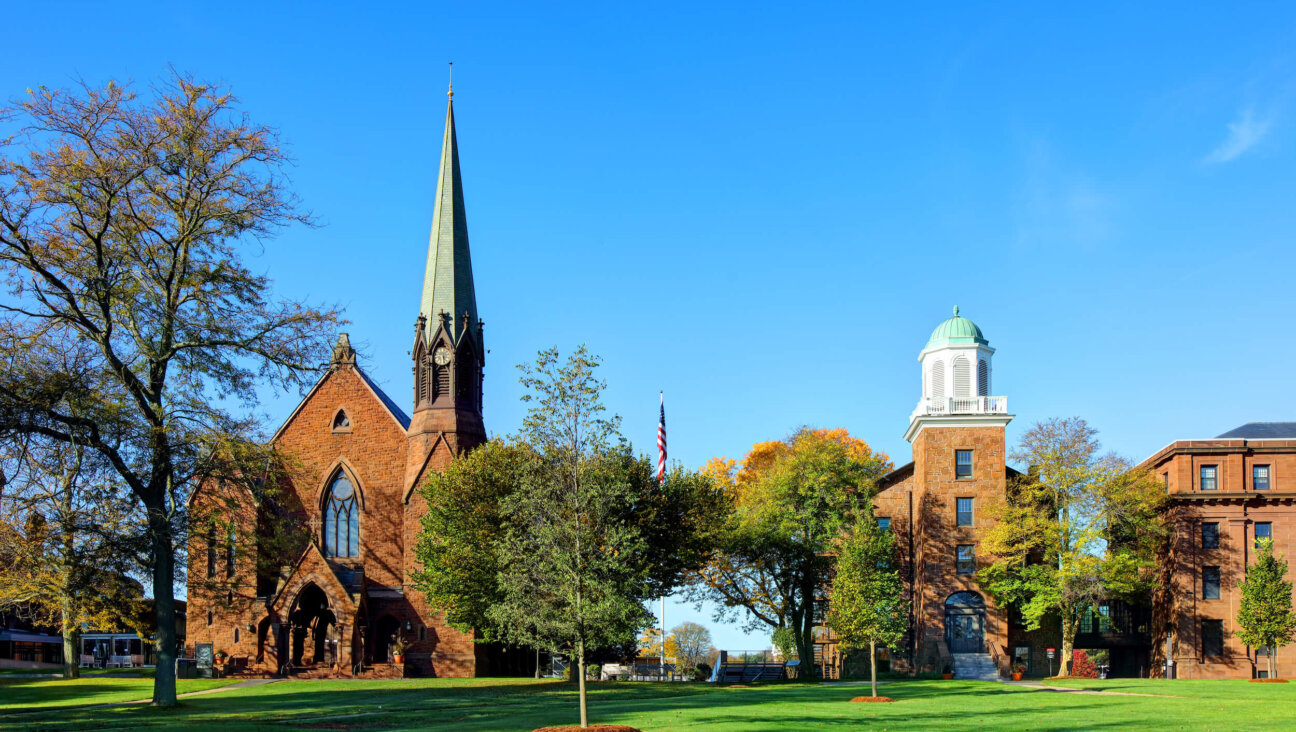Can This Rabbinic Revolutionary Make Hebrew Israelites Mainstream?

Image by Claudio Papapietro
Like synagogues in many old neighborhoods, the walls of Mount Horeb in the Bronx are lined with the framed photos of esteemed elders who have passed on. There is a faded photo, too, of the Western Wall, and Stars of David.
But at this Bronx synagogue, an Ethiopian flag also hangs above a series of aged newspaper clippings, chronicling the history of the devout African-American community that congregates here, one whose story has unfolded on the margins of the Jewish world.
This particular weekend, the crowd at Mount Horeb — some in dashikis, turbans and knit caps; others with three-piece suits and yarmulkes — have come to hear from a leader-in-waiting who promises to move his community, known as the Hebrew Israelites, at least somewhat closer to the center of mainstream Jewish life.
Rabbi Capers C. Funnye Jr. has already risen to prominence in the Jewish world as a charismatic cleric, a first cousin once removed to First Lady Michelle Obama and the first African-American member of the Chicago Board of Rabbis, with a synagogue — Beth Shalom B’nai Zaken Ethiopian Hebrew Congregation — listed on the Guide to Jewish Living website of the local Jewish federation. At the same time, he is vice president of the International Israelite Board of Rabbis, the only rabbinical body in the separate world of the Hebrew Israelites.
Around 200 members gathered at Mount Horeb on June 27 to hear Funnye; to honor a cherished patriarch, Chief Rabbi Wentworth Arthur Matthew, and to celebrate 96 years of history. It was, among other things, a chance for the New York community to listen to Funnye, who was nominated last October to assume the long-vacant title that Matthew once held. A statement from the board announced that Funnye had successfully “passed the penultimate step to becoming the first Black Chief Rabbi of the 21st century.” The final decision on his elevation, the board noted, will be made at a conclave of rabbis in the fall.
There have been only two other chief rabbis in the community’s history, and the position has been vacant for 16 years.
As Funnye stood to address the crowd, children were hushed, the doors to the street closed. One community member raised her hand and asked what Funnye would do to bring order to the fractious world of Israelites. Another wanted to know what would be done to bring in funding and attract new congregants.

Proclaiming God: Deborah Ruben of the Beth Elohim choir rises in song during prayer. Image by Claudio Papapietro
“The world is not going to come here looking for us,” said Funnye, who has, more than any other leader, developed relationships with other branches of Judaism outside the Israelite community. “In order to grow, we need to come out and project who we are.”
Funnye is clear on the question of where the Israelites fit in the larger Judaic world: They are a member of the Jewish family, but also distinct. “We are not Ashkenazi; we are not Mizrachi, Sephardi or Yemenite,” Funnye said. “But we are a part of the house of Israel.”
In taking this stand, Funnye promises not only to challenge the long-held separatism of many in the Israelite community; he may also challenge mainstream Jewry’s image of the group as one that is irrelevant to Jewish life, and as a group with easily-dismissible claims to Jewish identity.
Diane Tobin, founder and CEO of Be’chol Lashon, a group that promotes Jewish racial diversity, called Funnye “practical and pragmatic.” His leadership could provide “an opportunity to move beyond biblical debates mired in the politics of race,” Tobin said, “and toward building community.”
Unlike any past Israelite chief rabbi, Funnye went through a conversion in a Conservative beit din, or Jewish court; almost his entire Chicago congregation has done so, too. He is a longtime member of the American Israel Public Affairs Committee, works with the World Zionist Organization, is on the board of Chicago’s Jewish Council on Urban Affairs and quotes from prominent rabbis of mainstream Judaism, such as Aryeh Kaplan and Abraham Joshua Heschel.
In a community notable for a sprawling spiritual diversity and sometimes wary independence, the man nominated to unify the Israelites is one who has embraced a more normative idea of what it means to be Jewish.
Funnye’s agenda in the months since his nomination ranges from the practical (hiring someone to answer phones for the board, offering family counseling, providing support for clerics, raising money from Jewish organizations) to the more doctrinal (affirming that “Torah is the supreme law of the House of Yisrael, based upon the prophetic principles”). His plan points toward a broader formalization and unification of Israelite ritual, including the eventual adoption of a standardized Israelite prayer book, or siddur, and a generally accepted body of Halacha, or traditional religious legal code.
It was in 1919 that a Caribbean-born man named Wentworth Arthur Matthew, now revered as the founding chief rabbi of this group, formed a congregation that would inspire generations of black Americans like Funnye to observe Torah as they understood it. The community he established, the Commandment Keepers Ethiopian Hebrew Congregation, in Harlem, opened its doors as New York City was beginning to swell with waves of African-Americans from the Caribbean and the South. Nationalism and spirituality mingled in the northern metropolis, which had also seen a huge influx of Jews from Eastern Europe at the turn of the century.
Early congregants were coming from church-going families, but Matthew preached that many African-Americans were descended from the biblical Israelites and that they should shrug off their Christian practice and return to the Jewish way of life, their true faith. While there were other groups promoting the same teaching, over time, Matthew’s community emerged as the most orthodox group, whose practice cleaved more closely to Judaism. A charismatic immigrant from the Caribbean island St. Kitts who was also a carpenter, Matthew became the central figure in New York’s emergent Torah-observant community of Israelites.
Matthew reached out to New York’s Jewish establishment, but over the course of four decades no formal relationship materialized. Though Matthew did receive support for his work from B’nai B’rith International, his application for membership to the New York Board of Rabbis was turned down twice, in part because his smicha, or ordination, was given to him not by a body they recognized, but by his mentor, another Israelite cleric. The head of the American Pro-Falasha Committee, a group devoted to the rescue of Ethiopian Jews, derided Matthew’s practice as a “mixture of superstition and ignorance that has nothing to do with Judaism.”
But among some Jewish liberals, Matthew did have advocates, who spoke out in support of the burgeoning community. Rabbi Irving J. Block, an ecumenically minded Conservative rabbi, urged other Jews to accept Matthew and his synagogues. “They are a part of us, spiritually tied to us, and yet they are estranged from us,” he lamented before the Commission on Synagogue Relations in 1964. “Worse still, we are estranged from them.”
In 1965, another liberal-minded group called Hatzaad Harishon (“the first step”) sought to bring Israelites and other black Jews into the fold. The group organized integrated summer camps, an Israeli folk dance troupe and conferences. But it also ultimately pushed for Israelites to convert to Judaism in a conventional beit din overseen by non-Israelite rabbis. While Matthew did perform a kind of ceremony of teshuvah, or return, for new adherents, some members at Hatzaad Harishon did not recognize this as being equivalent to conversion.
“They were trying to circumvent Rabbi Matthew, saying: ‘We’re going to make you just like us,’ as opposed to appreciating the uniqueness and diversity,” said Rabbi Sholomo Ben Levy, president of the International Israelite Board of Rabbis.
Hatzaad Harishon was successful in “interrupting the expectation that all Jews are light-skinned, but [the group] ran into difficulties,” said Janice Fernheimer, author of “Stepping Into Zion: Hatzaad Harishon, Black Jews and the Remaking of Jewish Identity.” There were internal rifts within the group, stemming from the question of whether to require “black Jews to convert according to Halacha or [to accept] their identity claims at face value.”
Divided by the question of conversion, in 1972 the group disbanded. The effects of those early attempts, Fernheimer said, “continue to cascade throughout larger discourses of Jewish identity.”
Developing apart from the mainstream, the community founded by Matthew thrived and diversified. Israelite synagogues spread through New York’s boroughs and across the country. Nationwide there are today a dozen congregations that recognize the authority of the Israelite Board; membership in these synagogues range from less than 75 to 200, according to the board.
There are also thousands of Israelites who do not associate with the board. Some Israelites embraced a more strident nationalism. In Chicago, one leader named Ben Ammi Ben Israel (who had not studied with Matthew but moved in similar circles) led a group of his followers out of the country, eventually settling in Dimona, Israel. Another splinter group for some years frequented Times Square, their members wearing colorful garb and preaching on street corners. This group, the Israelite School of Universal Practical Knowledge, has very distant and long-since severed ties to Matthew. Theologies diverge and none of these groups have ever had an institutional relationship with the Israelite Board.
When Matthew died in 1973, a student of his, Rabbi Levi ben Levy, became the chief rabbi of the board. Ben Levy revamped Matthew’s rabbinical academy and described the school as a haven for Israelites, “where young men can study to be rabbis, a place where our beit din can meet to solve the problems within our community.” Describing the movement, he declared, “We are free and we are independent.”
•
Meanwhile, a young Funnye was looking for God. He was born in Georgetown, South Carolina, an hour north of Charleston, and was raised on Chicago’s Southside, in the African Methodist Episcopal Church. He briefly considered entering the AME clergy. But Funnye, like other black nationalists of his time, had begun to see Christianity as a foreign religion, something imposed by whites. “You give a projection of the imagery of God or God’s son, and that image looks just like the people that have been calling you the n-word,” Funnye said. “If that’s what Christian heaven looks like, I’d rather not go.”
He tried other Christian denominations, read about Islam (but was turned off by the role Arab Muslims played in African slavery), and in the early ’70s discovered a Southside temple headed by Rabbi Robert Devine that taught that African-Americans were descendants of the ancient Israelites. Devine’s syncretic worship included Hebrew and Christian scripture. (In this congregation, Jesus Christ was depicted as a black man.)
The next year, Funnye learned about ben Levy’s New York Israelite Academy and was drawn in by the practice of Judaism that was offered there, one closer to traditional Judaism and with no Christological elements. Like mainstream Jewish seminaries, the Israelite academy taught Talmud alongside Torah. Funnye enrolled, studied remotely and in 1985 earned his smicha.

Davening: A worshipper at B'nai Adath Kol Beth Yisrael follows the service in his Hebrew-English language psalm book. Image by Claudio Papapietro
On top of his Israelite education, and with ben Levy’s encouragement (“Get all the education you can,” he was told), Funnye also received a bachelor’s and a master’s degree from Chicago’s Spertus Institute for Jewish Learning and Leadership. Spertus opened doors for Funnye in mainstream circles; he recalled meeting dozens of Jewish luminaries, including Louis Jacobs, Jerzy Kosinski and Elie Wiesel.
Perhaps because he was a new arrival to the community and had not experienced the community’s earlier, failed attempts at outreach, Funnye had a fresh perspective. He was curious to interact with the Jewish world, and he went through a conversion overseen by a Conservative beit din. It was precisely the issue that had torn through the community years before. But Funnye saw no problem with mainstream conversion, and undertook it with the approval of his teacher, ben Levy.
“I had been a Jew in my heart,” Funnye said. He felt that “going through conversion only solidified who I was. I am a Hebrew, I am an Israelite, I am a Jew, I embody them all.”
With his mainstream pedigree, Funnye has become a public face for multiracial Judaism. Unlike some of his predecessors and peers, he was able to work within the mainstream without fundamentally challenging pervasive notions of what it meant to be Jewish. He set up the Alliance of Black Jews in 1995 and became an associate director at Be’chol Lashon. Though unaffiliated with a major denomination, Funnye applied and became a member of Chicago’s Board of Rabbis in 1997. His mentor, the last chief rabbi, died in 1999.
Today Funnye’s synagogue, the largest Israelite congregation of its kind, has regular pulpit exchanges with other Jewish synagogues in the city. He sees his community as an entry point; congregants have the Jewish literacy to worship anywhere. “Now wherever they go, they are grounded and steeped in Torah,” Funnye said.
But the memories of exclusion are still fresh. This country’s history of segregation and racism reverberates; some congregants see their earlier rejection as bound up in America’s tortured racial politics. There are members alive who studied with Matthew at the Commandment Keepers; some remember the failed attempts at integration with mainstream Jewry in the 1960s. Others bristle at the fact that they are, seemingly ad infinitum, asked to explain how they came to observe Torah and call themselves Israelites.
“There are still people who will not go through a formal conversion,” said Rabbi Baruch A. Yehudah, who leads Brooklyn’s B’nai Adath Kol Beth Yisrael. “It is still too much to give someone else the authority to say, ‘You are allowing me to be a Jew according to your standards.’”
Yehudah, who is a member of the Israelite board and dean of the rabbinical academy, described being interrogated by Hasidic rabbis who questioned his credentials. “Look at me, born Baruch Yehudah, circumcised on the eighth day, keeping more Torah than most,” Yehudah said. “You’re going to tell me I’m not a Jew, not an Israelite? Who gave you that right?”
Rabbi Bradley Artson, dean of the Ziegler School of Rabbinic Studies a Conservative Jewish seminary at American Jewish University, looks at the Israelites’ claims to Jewish identity from a historical point of view that sidesteps the politics of conversion.
“Never has there been a single, monolithic Judaism,” he said. “There have always been different communities of Judaism existing side by side. Some have joined together, like the various sects after the destruction of the Second Temple, or the Hasidim and Mitnagdim in the early modern period; others have left entirely, like the Nazarenes or the Frankists. With regards to the Israelites, what I’d like to work toward is to find a common path together while still honoring the Jewishness they claim. And I’d like to achieve this together, without anyone feeling subservient or judged.”
During his visit to Mount Horeb, Funnye delivered the sermon. Men sat on the right side of the room, women on the left. As per synagogue custom, all worshippers had removed their shoes. Funnye had changed into a black robe adorned with a Star of David. He invoked the early 20th-century black nationalist Marcus Garvey (“One God! One Aim! One Destiny!”), spoke about the killing of nine worshippers at the AME church in Charleston, South Carolina, and asked for those of the Israelite community to find common ground as they begin another year. “I don’t care about how long your tallit is, how small your kippah is or what color your turban is,” he said. There was scattered applause. “What I care about is whether you are willing to work, to build on the foundations we’ve been given.”
Contact Sam Kestenbaum at [email protected]. Or follow him at @skestenbaum

I hope you appreciated this article. Before you go, I’d like to ask you to please support the Forward’s award-winning journalism this Passover.
In this age of misinformation, our work is needed like never before. We report on the news that matters most to American Jews, driven by truth, not ideology.
At a time when newsrooms are closing or cutting back, the Forward has removed its paywall. That means for the first time in our 126-year history, Forward journalism is free to everyone, everywhere. With an ongoing war, rising antisemitism, and a flood of disinformation that may affect the upcoming election, we believe that free and open access to Jewish journalism is imperative.
Readers like you make it all possible. Right now, we’re in the middle of our Passover Pledge Drive and we still need 300 people to step up and make a gift to sustain our trustworthy, independent journalism.
Make a gift of any size and become a Forward member today. You’ll support our mission to tell the American Jewish story fully and fairly.
— Rachel Fishman Feddersen, Publisher and CEO
Join our mission to tell the Jewish story fully and fairly.
Only 300 more gifts needed by April 30























